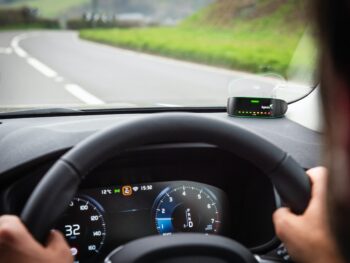Fleet decarbonisation starts with drivers, not vehicles, says Lightfoot
Fleet decarbonisation strategies should factor in drivers first, then vehicles later, to ensure instant carbon reductions, Lightfoot has asserted.

Lightfoot says any business can massively reduce its carbon output within a matter of weeks by helping its employees to drive better
According to the driver coaching technology specialist, better driving can bring about carbon reductions of around 15% almost immediately – cutting fleet costs while also giving decarbonisation strategies an immediate boost amid the longer-term transition to zero-emission vehicles.
Paul Hollick, managing director at Lightfoot, also said a focus on driver decarbonisation could provide a a rapid return for the many businesses needing to report emission reduction plans this year.
Hollick believes there are a number of pillars involved in decarbonisation, with the main three being vehicle choice, operational decisions and drivers.
“Decarbonisation is on the radar of every business this year, but it is not simply a switch that can be flicked for an entire fleet straight away. You need to look at decarbonisation as a three-pronged assault with varying timescales.
“In the longer term, whether it be in electric, hydrogen, synthetic fuel or just much cleaner internal combustion engines, vehicle choice will have the ultimate effect on decarbonisation,” he said.
“In the medium term, there are operational decisions a business can make which will reduce carbon emissions, such as where and how they source fuel, what routes they take, and how the business chooses to work, either through less miles driven or switching to alternative means of transport.
“But in the short term, there is one clear winner when it comes to decarbonisation: the driver. Any business can massively reduce its carbon output within a matter of weeks by helping its employees to drive better. Being more efficient behind the wheel could reduce carbon output by as much as 15%, which also then has the added benefit of lower running costs.”
For some fleets, the viability of electric commercial vehicles remains unclear due to various operational and economic factors.
However, this summer also sees larger businesses having to report their carbon emissions as part of their ESOS phase 3 reporting, while also detailing how they are going to take steps to reduce it in future.
The ZEV mandate – which means manufacturers must sell a higher proportion of electric vehicles as part of their total registrations – is now law in the UK and will see the choice of petrol and diesel models reduce in the coming years.
Lightfoot says that decarbonising drivers buys a business time to make longer-term electrification decisions and “allows it to make strategic decisions from a position of strength, where it is already reducing emissions and costs, irrespective of the vehicles it is running”.
And this could alleviate the pressure to change to electric compared to a fleet seeing its emissions – and therefore costs – unchanged, or even rising.
“You need to look at each driver, and their role, individually. There is no point being dogmatic and just saying every driver must be in an electric vehicle, and therefore the decarbonisation box has been ticked, and the job done,” elaborated Hollick.
“Instead, set yourself the target of ‘How do we decarbonise as effectively as possible this year first?’. Only then can you look at next year, or the year after that. Decarbonisation needs to happen in incremental steps – but make sure those steps are as big as practically possible.”
Lightfoot also says there is still a decarbonisation issue to manage once electric vehicles are on board.
“While there are no tailpipe emissions, the electricity used still creates emissions. The Lightfoot system not only makes running EVs more viable from a practical perspective, but also ensures that their carbon footprint is as light as possible, by using as little energy as possible.
“That way, a fleet can truly claim it has done everything possible to decarbonise,” Hollick stated.












